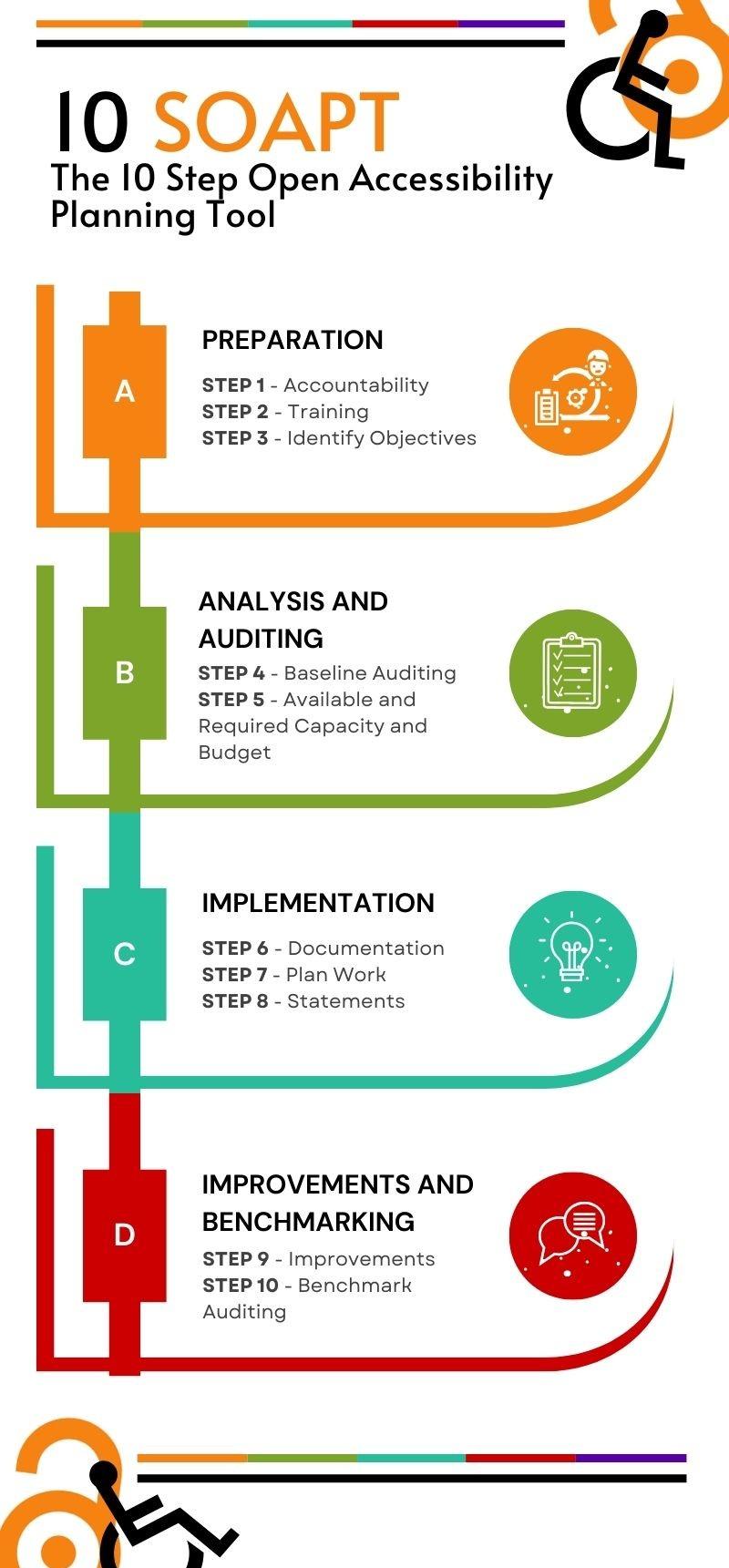Our Planning Tool - 10 SOAPT
10 SOAPT
The 10 Step Open Accessibility Planning Tool
Our custom planning tool has been developed by Open Book Futures to help small presses achieve accessibility across their organisation. It consists of 10 steps organised into 4 sections A-D. For each step, we have developed guidance that is hosted here on our Copim Compass area that will help you understand it fully. Our guidance is organised into 5 areas: Plan, Check, Learn, Communicate and Evidence, and we link to the exact areas of each of those that are relevant to each of the 10 steps below.
You can also access 10 SOAPT formatted as a spreadsheet: 10 SOAPT [Google Sheets]
10 SOAPT
Section A Preparation
Step 1 Accountability
Appoint a person to co-ordinate accessibility, who could be a dedicated accessibility professional or someone who has a wider portfolio of work that includes accessibility too. However, it's also important to remember that some accessibility work will be completed by almost everyone at an organisation.
Step 2 Training
Plan technical digital accessibility training and support the identified staff to develop skills. See our Courses and Training Materials and Guidance pages. You can also look up a summary of your country's legislation and learn more about available standards in our section Learn.
Step 3 Identify Objectives
Once relevant staff have been identified and trained, some organisational accessibility objectives can be devised through requirements gathering exercises. Any organisation should aim to meet legal minimum requirements, but it's possible to be exempt from that (this requires work to evidence), and you may decide to go beyond in some areas if it fits with your organisational values. Also, your readership might already have made accessibility requests you haven't been able to meet yet, or you could survey your end users to capture this 'reader voice' in terms of accessibility requirements. Finally, it's possible there are some community or discipline specific considerations to include as well.
Section B Analysis and Auditing
Step 4 Baseline Auditing
Audit the current accessibility of all aspects of the organisation, including the frontlist and backlist book files, the website functionality and the backend submission platform. You could complete this yourself using self auditing, or employ an external auditor. You could also look at assessing current organisational knowledge, attitudes towards and motivations for engaging with accessibility work. You can find our overall guidance on auditing, including our custom Checklist OARC here: Check.
Step 5 Available and Required Capacity and Budget
Improving accessibility requires dedicated time and money, and a full consideration of where this can be diverted to accessibility goals will help with planning. It is likely that you will have some idea of how long book production tasks take, and how much extra work accessibility improvements will add to that, but it could be that you will need to understand more about the relative simplicity or complexity of individual accessibility requirements (like ALT text, or checking colour contrast). You can see our estimation of this within our custom Checklist tool OARC here: The Open Accessibility Review Checker (OARC).
Section C Implementation
Step 6 Documentation
Capturing the results of identifying objectives, auditing, and analysing resources might happen across a range of documentation that could include: an accessibility policy, roadmaps, strategic plans, updated author guidelines, or other documentation. We offer guidance on producing documentation in our sections on Author Guidelines and Accessibility Policy.
Step 7 Plan Work
We recommend that frontlist and backlist/remediation are considered separately, and separate plans are made for the website including the backend submission process.
Step 8 Statements
Publish accessibility statements and roadmaps on the organisation's website, and include VPATs and public policies if that is decided on. Our guidance on each is available at the links.
Section D Improvements and Benchmarking
Step 9 Improvements
Incorporate planned accessibility improvements into workflows and complete the plan.
Step 10 Benchmark Auditing
Audit the accessibility and organisational knowledge at regular intervals within the plan to showcase improvements.

